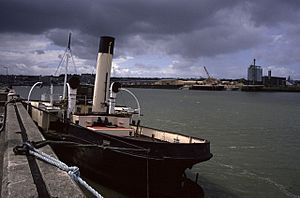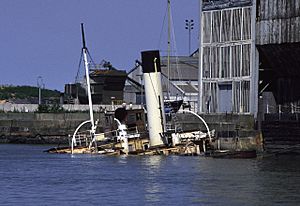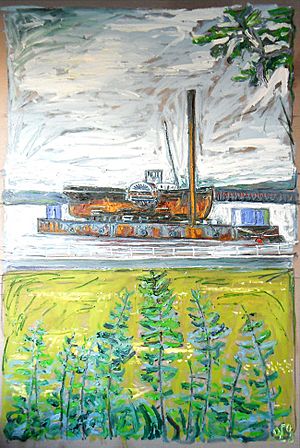PS John H Amos facts for kids

John H Amos in 1988
|
|
Quick facts for kids History |
|
|---|---|
| Name | John H Amos |
| Owner | Tees Conservancy Commissioners |
| Port of registry |
|
| Ordered | 1931 |
| Builder | Bow, McLachlan & Co, Paisley, Scotland |
| Cost | £18,500 |
| Yard number | 497 |
| Launched | 1931 |
| In service | 1931 |
| Homeport | Chatham, Kent |
| Status | non-operational, on barge |
| General characteristics | |
| Type | Tugboat |
| Tonnage | 202 tons |
| Length | 110 ft (34 m) |
| Beam |
|
| Installed power |
|
| Propulsion | 2 diagonal compound engines with Bremme valve gear |
| Speed | 13 knots (24 km/h) |
| Crew | 6 |
The John H Amos is a special type of tugboat called a paddlewheel tug. It was built in Scotland in 1931. This tugboat is important because it was the very last paddlewheel tug made for private companies. Today, the Medway Maritime Trust owns it.
The John H Amos is one of only two paddle tugs built in Britain that are still around. The other one is the Eppleton Hall, which is kept safe at the San Francisco Maritime National Historical Park in San Francisco, California.
Contents
Building the John H Amos
The John H Amos was ordered by the River Tees Conservancy Commissioners. It was built by Bow, McLachlan and Company Ltd. in Paisley, Scotland. The tugboat was named after John Hetherington Amos, who was the Secretary to the Commissioners and passed away in 1934.
Before the tugboat was finished, the building company went out of business. Another company, National Shipbuilders Securities (NSS), took over the shipyard. NSS completed the John H Amos using materials that were already there. This meant some parts of the tugboat were better than planned, while others were not as good.
When the tugboat was first tested, engineers found that its boilers could not make enough steam. This meant the tug could only go 11 knots, instead of the planned 13 knots. Even though it was finished in 1931, the Tees Conservancy Commissioners did not accept the tug for two more years. This was because they waited until all the necessary repairs were done to meet the original design.
How the Tugboat Operated
From 1940 to 1967, the John H Amos was very busy. It carried barges to dredgers and dumping grounds. It also towed dredgers that could not move on their own. The tugboat also helped move crews around. It had a crew of six people: a master, a mate, two engineers, a stoker, and a deck hand.
Some people said the John H Amos was not very good at being a tugboat. So, it was given a special certificate to carry up to 144 passengers. Near the mouth of the River Tees, there was a pier with a light called the Fifth Buoy Light. Ships used this light to know they were on the right path. In the middle of this structure was a building, sometimes used as a dance hall. The John H Amos would take passengers to this building.
Like all paddle steamers, the John H Amos could float in shallow water. When it towed barges, they were always tied to the side of the tug. It would usually use only one paddle. Even though the tug was wide, this design helped it work well in shallow water. This is why it was used for so many years.
First Time Being Preserved
The John H Amos stopped working in 1967. Two years later, the Tees and Hartlepool Ports Authority gave it to the County Borough of Teesside. The idea was for it to be for "The People of Cleveland." In December 1971, the tugboat was moved from Middlesbrough to Stockton Corporation Quay. The plan was to use young trainees to turn the tug into a floating museum.
From 1976 to 1999
Because of changes in government funding, the project to restore the boat with young trainees was stopped. The boat was then put up for sale. Two businessmen from the River Thames bought the tugboat for £3,500. They owned the only steam-powered tug fleet in the UK. After some debate in the council about the sale, the John H Amos left Stockton on March 4, 1976. About 400 people watched it leave, and a local brass band played Rule Britannia.
The tugboat was renamed Hero and became part of the International Towing Ltd (ITL) fleet. This company was based at Gun Wharf, Chatham Dockyard. By the end of 1976, the business partners split their fleet. The John H Amos moved from Gun Wharf to Milton Creek, and then to Faversham Creek.
When HMS Endurance returned from the Falklands War, the Royal Navy offered the new Medway Maritime Trust two places to moor their boats.
Second Time Being Preserved
So, the John H Amos moved to Anchor Wharf at the Historic Dockyard. Later, when the Dockyard Trust got the submarine HMS Ocelot, the John H Amos was moved to a new spot. Sadly, it ended up sitting on a hidden concrete lump underwater. This caused a hole in its hull, and it sank at its mooring. Luckily, the dockyard trust then allowed it to be moored on a free slipway.
In November 1999, the John H Amos was added to the National Historic Fleet. This means it is considered a very important vessel for the country and should be preserved.
In 2001, the ownership of the tugboat was given to the Medway Maritime Trust. The Science Museum helped with funding. Money for its restoration also came from the Heritage Lottery Fund, National Historic Ships, and Rochester Bridge Trust.
The tugboat was supposed to be moved onto a slipway in 2004, but there were delays. In 2006, the trust got Portal Narvik, which was part of the old Tank Landing Ship HMS Narvik. After raising money to pay for the lift, one of Europe's largest sea cranes, the GPS Atlas, lifted the John H Amos onto Portal Narvik in May 2009.
Now, the two vessels are moored together in Chatham Docks. The John H Amos will be cleaned and fully documented there. It is waiting for more money to be raised for its full restoration. In 2008, an artist named Billy Childish, who was born in Chatham, made several paintings of the John H Amos. One painting shows the tugboat safely on the Portal Narvik pontoon, floating in the middle of the river.



